Contact
Click below to speak to a Diamond Consultant or customer service.
or
Live Chat8:00 am - 6:00 pm CST (Mon - Fri)

Click below to speak to a Diamond Consultant or customer service.
or
Live Chat8:00 am - 6:00 pm CST (Mon - Fri)
Virtually all diamond cuts sold for use in jewelry are one of ten round or fancy diamond shapes. The most popular diamond shapes are:
Following is an introduction to each shape, including information on how to determine the best combination of size, color, and clarity for your needs. View our side-by-side comparison of each diamond shape to see how shape affects apparent size as well.

The round cut diamond is the most popular diamond shape, representing approximately 75% of all diamonds sold. Due to the mechanics of its shape, the round diamond is generally superior to fancy shapes at the proper reflection of light, maximizing potential brightness. more on round diamonds…

The princess cut diamond, first created in 1980, is the most popular fancy diamond shape, especially for engagement rings. Like round cut diamonds, princess cut diamonds are a good choice for their flexibility in working in almost any style of ring. more on princess cut diamonds…

Because the oval diamond is a modified brilliant-cut (like virtually all round cut diamonds), the two diamond shapes possess a similar fire and brilliance. However, oval cut diamonds have the added advantage of an elongated shape, which can create the illusion of greater size. more on oval diamonds…

The marquise cut diamond is a football-shaped, modified brilliant-cut. Because the marquise diamond is long and narrow, it can also create the illusion of greater size. Carat for carat, the marquise diamond has one of the largest surface areas of any diamond shape, making it a good choice when trying to maximize perceived size. more on marquise diamonds…

The modified brilliant-cut pear shaped diamond is a combination of a round and a marquise shape, with a tapered point on one end. Ideally, a pear shaped diamond should possess excellent or very good symmetry. The point should line up with the apex of the rounded end. The shoulders and wings (the upper and lower curves on the right and left side of the diamond) should form uniform, symmetrical curves. more on pear shaped diamonds…

The cushion cut diamond combines a square cut with rounded corners, much like a pillow (hence the name). This classic cut has been around for almost 200 years, and for the first century of its existence was the most popular diamond shape (similar to round cut today). Refinements in cut have led to a recent resurgence in popularity. more on cushion cut diamonds…

The unique look of the emerald cut diamond is due to the step cuts of its pavilion and its large, open table. Instead of the sparkle of a brilliant-cut, emerald cut diamonds produce a hall-of-mirrors effect, with the interplay of light and dark planes. Often, inclusions or body color are easier to see in an emerald cut diamond. more on emerald cut diamonds…

The asscher cut diamond was first produced in 1902 by the Asscher Brothers of Holland, an is a forerunner to the emerald cut. The asscher cut diamond is similar to the emerald cut, but in a square shape with larger step facets, a higher crown, and a smaller table. This combination often produces more brilliance than the emerald cut. more on asscher cut diamonds…

The radiant cut diamond is the first rectangular cut to have a complete brilliant-cut facet pattern applied to both the crown and pavilion, creating a vibrant and lively diamond. The modified square shape is a nice bridge between a cushion and a princess cut, and for that reason looks beautiful set with both rounded or square cornered diamonds. more on radiant cut diamonds…

The modified brilliant-cut heart shaped diamond is a unique and unmistakable symbol of love, popular in solitaire pendants as well as rings. Heart shaped diamonds less than .50 carats may not be a good choice, since the heart shape is more difficult to perceive in smaller diamonds, especially after they are set in prongs. more on heart shaped diamonds…
Most people who receive diamonds as a gift or for an engagement have a shape preference. While other factors (such as price and quality) should be determined by the purchaser, the choice of shape should include input from the recipient of the diamond, if at all possible. This is especially true for fancy shape engagement diamonds.
Visit the Lumera Diamond Buying Guide for additional tips and advice.
SEARCH FOR A DIAMOND NOW
